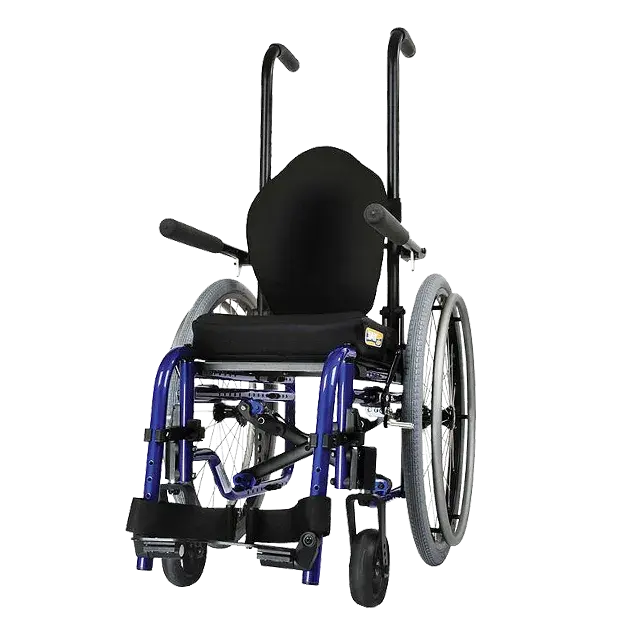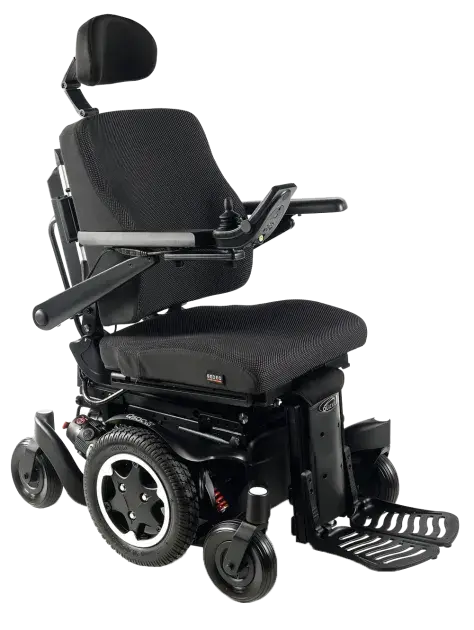
13 Practical Steps to Keep Your Power Wheelchair in Optimal Condition
Electric wheelchairs have revolutionized mobility for people with physical limitations, becoming an ally that provides independence, freedom, and a better quality of life. Thanks to their advanced design, these devices allow users to move comfortably and safely in different environments, offering the possibility of maintaining a more active and inclusive lifestyle.
At the heart of every electric wheelchair lies an essential component that ensures its proper operation: the battery. This element acts as the system’s true lifeline, since without energy, it would be impossible to power the motor, controls, or additional functions that characterize these chairs.
In this article, we explain what batteries for electric wheelchairs are, how they work, what types exist, and which are the best practices to care for them. This way, you can maximize your chair’s autonomy and ensure optimal performance to accompany you in your daily mobility.
We invite you to read: Everything You Need to Know About Motorized Wheelchairs
What Are Batteries for Electric Wheelchairs?
The batteries of electric wheelchairs are rechargeable devices that store and provide the energy needed for the motor, control systems, and electronic functions of the chair. They work through electrochemical reactions that convert chemical energy into electrical energy, allowing the chair to move safely and autonomously.
There are different types of batteries, each with specific advantages and considerations. The main types are:
-
Lead-acid batteries: a traditional and affordable option for electric wheelchairs. They contain lead dioxide and spongy lead immersed in sulfuric acid, producing electrical energy through a chemical reaction. Lead-acid batteries are known for their reliability and durability, making them a popular choice.
However, they tend to be heavier and have a lower energy density compared to more modern alternatives. They may also require regular maintenance, such as checking water levels and ensuring proper charging practices.
-
Gel batteries: a type of valve-regulated lead-acid (VRLA) battery. They use a gel-like electrolyte instead of a liquid, making them more resistant to leaks and spills. Gel batteries are usually maintenance-free, require less attention, and offer a longer lifespan than traditional lead-acid batteries.
They are a suitable option for electric wheelchairs due to their sealed design, which improves safety and allows flexible installation. While gel batteries are more expensive initially, their extended lifespan and lower maintenance needs can make them a cost-effective choice over time.
-
Lithium-ion batteries: a more advanced and lightweight option for electric wheelchairs. They use lithium ions that move between positive and negative electrodes to generate electrical energy. Lithium-ion batteries are known for their high energy density, longer lifespan, and lighter weight compared to lead-acid batteries.
In addition, they offer faster charging times and generally require no maintenance. While lithium-ion batteries tend to have a higher initial cost, their superior performance and convenience make them increasingly popular in the electric wheelchair market.
Which One Should You Choose?
Choosing the right battery for your electric wheelchair is not just a matter of price. There are several factors to consider before making a decision:
Available Budget
-
If you’re looking for the most affordable and reliable option, lead-acid batteries are usually the first choice.
-
If you can invest a little more, gel batteries offer a better balance between initial cost and durability.
-
Lithium batteries, though more expensive upfront, are cost-effective in the long term thanks to their longer lifespan and lower replacement needs.
Autonomy and Lifestyle
-
If you use your electric wheelchair frequently or travel long distances, lithium batteries are ideal due to their greater capacity and shorter charging times.
-
For occasional use or short trips, lead-acid or gel batteries may be sufficient.
Battery Weight
-
Lead-acid batteries are heavier, which can affect maneuverability in some models.
-
Lithium batteries stand out for being lighter, making transport easier and reducing strain on the motor.
Maintenance and Convenience
-
If you prefer not to worry about constant maintenance, both gel and lithium batteries are the most convenient since they require no upkeep.
-
Lead-acid batteries do require periodic inspections and stricter charging practices to preserve their lifespan.
Availability and Compatibility
-
Not all wheelchairs are designed to work with lithium batteries. Before switching your current battery, consult the manufacturer or a specialist.
-
Lead-acid and gel batteries are more widely available and compatible with most models.
If you’re looking for immediate savings, go with lead-acid. If you prefer a middle ground between cost, durability, and safety, gel is the recommended option. And if you want autonomy, lightness, and maximum efficiency for your electric wheelchair, lithium batteries are the best long-term investment.
The Role of Batteries in Electric Wheelchairs
Batteries are the beating heart of an electric wheelchair — they store and supply the energy that powers the motor, control systems, and auxiliary functions such as lights or tilt mechanisms. Their performance directly determines the chair’s autonomy, speed, and reliability during use.
Here are the key functions of batteries in these mobility aids:
-
Provide power for movement: batteries supply energy to the motors that drive the wheels, allowing users to move forward, backward, and turn effortlessly.
-
Enable control systems: they power the joystick and electronic components that regulate speed and direction, ensuring precise handling.
-
Support additional functions: modern wheelchairs may include lighting systems, recline or elevation features, and connectivity functions that depend entirely on the battery.
-
Ensure user autonomy: the battery’s capacity defines how far the user can travel without recharging — essential for maintaining daily independence.
For all these reasons, proper selection, care, and maintenance of the battery are vital to ensure consistent performance and to extend the chair’s service life.
How Long Does a Battery Last in an Electric Wheelchair?
The lifespan of a battery depends on several factors, such as the type of battery, its use frequency, the weight it supports, and the charging habits of the user. Generally speaking:
Lead-acid batteries last about 12 to 18 months.
Gel batteries can last 2 to 3 years.
Lithium batteries typically last between 4 and 5 years, or even longer with proper care.
In terms of autonomy per charge, most electric wheelchairs can travel between 15 and 30 kilometers, depending on the terrain, user weight, and battery condition.
Tips for Battery Care and Maintenance
To get the best performance and extend the life of your wheelchair’s battery, follow these recommendations:
Charge regularly: don’t wait until the battery is completely drained to recharge. Ideally, plug it in every night after use.
Avoid overcharging: disconnect the charger once it’s fully charged to prevent overheating and premature wear.
Store correctly: if you won’t use your wheelchair for several weeks, store the battery in a cool, dry place and recharge it at least once a month.
Inspect periodically: make sure terminals are clean and corrosion-free. For lead-acid batteries, also check fluid levels if applicable.
Use the right charger: only use chargers recommended by the manufacturer to avoid damaging the internal cells.
Keep away from extreme temperatures: both intense heat and cold can reduce the battery’s efficiency and lifespan.
With these simple care practices, you’ll ensure your wheelchair always has the energy it needs for your daily activities.
Signs of a Failing Battery
Recognizing the symptoms of a deteriorating battery can help prevent sudden malfunctions and guarantee your safety. Some common signs include:
Reduced range: if the wheelchair doesn’t cover the same distance as before, the battery may be losing capacity.
Slow charging: when a battery takes longer than usual to charge, it’s often an indicator of internal wear.
Irregular performance: sudden stops, power drops, or inconsistent speeds may signal electrical problems.
Physical deformation or overheating: any swelling or unusual heat during use or charging is a red flag — the battery should be replaced immediately.
Ignoring these symptoms can lead to total failure or even pose safety risks. Replacing the battery in time ensures your chair remains reliable and safe.
Where to Buy Batteries for Electric Wheelchairs
It’s crucial to purchase batteries from trusted suppliers that guarantee compatibility, quality, and manufacturer warranty. Avoid generic or low-cost options that may not meet the proper specifications for your wheelchair model.
At Loh Medical, we offer original batteries and authorized replacements for our electric wheelchairs and other mobility products. Our technical team can help you choose the right battery and provide professional installation and maintenance services.
If you’re looking for batteries for electric wheelchairs in Latin America, contact our nearest branch or visit our website for personalized assistance and reliable products.
Final Thoughts
Batteries are an essential part of electric wheelchairs, directly impacting autonomy, safety, and user comfort. Choosing the right type, performing regular maintenance, and following proper charging practices will maximize both their performance and lifespan.
When the time comes to replace your battery, trust certified providers who understand the specific needs of mobility equipment. At Loh Medical, we work to ensure every user has the energy they need to move forward—safely and independently.






